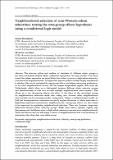Files in this item
Neighbourhood selection of non-Western ethnic minorities : testing the own-group effects hypothesis using a conditional logit model
Item metadata
| dc.contributor.author | Boschman, S. | |
| dc.contributor.author | Van Ham, Maarten | |
| dc.date.accessioned | 2015-10-08T13:39:59Z | |
| dc.date.available | 2015-10-08T13:39:59Z | |
| dc.date.issued | 2015-05-26 | |
| dc.identifier | 222356607 | |
| dc.identifier | 43d29a90-f605-4cde-8e37-456bdf97118d | |
| dc.identifier | 84940047512 | |
| dc.identifier | 000360805500010 | |
| dc.identifier.citation | Boschman , S & Van Ham , M 2015 , ' Neighbourhood selection of non-Western ethnic minorities : testing the own-group effects hypothesis using a conditional logit model ' , Environment and Planning A , vol. 47 , no. 5 , pp. 1155-1174 . https://doi.org/10.1177/0308518X15592300 | en |
| dc.identifier.issn | 0308-518X | |
| dc.identifier.other | ORCID: /0000-0002-2106-0702/work/64697528 | |
| dc.identifier.uri | https://hdl.handle.net/10023/7631 | |
| dc.description | The research leading to these results has received funding from the European Research Council under the European Union’s Seventh Framework Programme (FP/2007-2013)/ERC Grant Agreement no. 615159 (ERC Consolidator Grant DEPRIVEDHOODS, Socio-spatial inequality, deprived neighbourhoods, and neighbourhood effects) and from the Marie Curie programme under the European Union’s Seventh Framework Programme (FP/2007-2013)/Career Integration Grant no. PCIG10-GA-2011-303728 (CIG Grant NBHCHOICE, Neighbourhood choice, neighbourhood sorting, and neighbourhood effects). | en |
| dc.description.abstract | The selective inflow and outflow of residents of different ethnic groups is the main mechanism behind ethnic residential segregation. In many studies it has been found that ethnic minorities are more likely than others to move to high-ethnic-minority-concentration neighbourhoods. An important question which remains largely unanswered is whether this can be explained by own-group effects, including own-group preferences, or by other neighbourhood factors. We use unique longitudinal register data from the Netherlands, which allow us to distinguish between different ethnic minority groups and simultaneously to take into account multiple neighbourhood characteristics. This allows us to test own-group effects—the effect of the share of the own-ethnic group on neighbourhood selection—while also taking into account other neighbourhood characteristics such as housing market composition. Using a conditional logit model, we find that housing-market constraints can partly explain the moves of ethnic minorities to high-ethnic-minority-concentration neighbourhoods: own-group effects are also found to be important in explaining neighbourhood selection. There are, however, important differences between ethnic minority groups. While these effects together explain why Surinamese and Antilleans move to high-ethnic-minority-concentration neighbourhoods, Turks and Moroccans are still found to move to neighbourhoods with concentrations of minorities other than their own ethnic group. | |
| dc.format.extent | 20 | |
| dc.format.extent | 348977 | |
| dc.language.iso | eng | |
| dc.relation.ispartof | Environment and Planning A | en |
| dc.subject | Segregation | en |
| dc.subject | Neighbourhood selection | en |
| dc.subject | Ethnicity | en |
| dc.subject | Own-group preference | en |
| dc.subject | Conditional logit | en |
| dc.subject | HT Communities. Classes. Races | en |
| dc.subject | 3rd-DAS | en |
| dc.subject.lcc | HT | en |
| dc.title | Neighbourhood selection of non-Western ethnic minorities : testing the own-group effects hypothesis using a conditional logit model | en |
| dc.type | Journal article | en |
| dc.contributor.sponsor | European Research Council | en |
| dc.contributor.institution | University of St Andrews. University of St Andrews | en |
| dc.contributor.institution | University of St Andrews. Geography & Sustainable Development | en |
| dc.identifier.doi | 10.1177/0308518X15592300 | |
| dc.description.status | Peer reviewed | en |
| dc.identifier.grantnumber | ERC-2013-CoG | en |
This item appears in the following Collection(s)
Items in the St Andrews Research Repository are protected by copyright, with all rights reserved, unless otherwise indicated.

